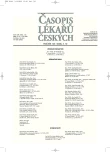-
Medical journals
- Career
Role of Percutaneous Vertebroplasty and Kyphoplasty in the Treatment of Oncology Disorders of the Spine
Authors: P. Ryška; S. Řehák 1; K. Odrážka 2; V. Maisnar 3; J. Raupach; V. Málek 1; O. Renc; K. Kaltofen 1
Authors‘ workplace: Radiologická klinika LF UK a FN, Hradec Králové ; Neurochirurgická klinika LF UK a FN, Hradec Králové 1; Klinika onkologie a radioterapie LF UK a FN, Hradec Králové 2; 2. interní klinika – oddělení klinické hematologie LF UK a FN, Hradec Králové 3
Published in: Čas. Lék. čes. 2006; 145: 804-809
Category: Original Article
Overview
Background.
The aim of the study is to present results of a prospective uncontrolled clinical study. Percutaneous vertebroplasty or kyphoplasty are minimally invasive methods based on polymethylmethacrylate (PMMA) bone cement application into the damaged vertebra. This leads to decrease of the pain and vertebral body stabilisation. Oncology disorders of the spine are relatively common, having a wide alternative of various methods of treatment. Patients, according to their findings and indication criteria, are treated surgically or conservatively, oncological treatment is usually based on radiotherapy. Authors discuss the role of these invasive procedures in the treating algorithm of patients with spinal metasthases and multiple myeloma.Methods and Results.
From September 2003 to December 2005, 21 percutaneous vertebroplasties in 14 patients, mean age 68.7 (47–80) year, were performed in our department. During one treatment session 1–2 vertebrae (total of 21 vertebrae) in level Th9 – L5 were treated. Vertebroplasties and kyphoplasty were performed under fluoroscopy guidance. Transpedicular acces was used. Totally, 3 asymptomatic complications were proved. As first, a bone cement leaked paravertebrally during L5 body treatment, as second, a bone cement leaked into paravertebral veins, and as third, a bone cement leaked into the intervertebral space. Visual analog scale (VAS) was 8.9 points before procedure, 1.9 point 3 months after procedure and 2.6 points 6 months after procedure. We did not prove a symptomatic or total complication.Conclusions.
According to our experience, percutaneous vertebroplasty is an effective alternative treatment of painful oncologic spine disease.Key words:
percutaneous vertebroplasty, percutaneous kyphoplasty, spinal metastasis, management of spinal metastases, myeloma.
Labels
Addictology Allergology and clinical immunology Angiology Audiology Clinical biochemistry Dermatology & STDs Paediatric gastroenterology Paediatric surgery Paediatric cardiology Paediatric neurology Paediatric ENT Paediatric psychiatry Paediatric rheumatology Diabetology Pharmacy Vascular surgery Pain management Dental Hygienist
Article was published inJournal of Czech Physicians

-
All articles in this issue
- Interstitial Microdialysis in the Clinical and Experimental Medicine
- Glomerular Filtration Rate Prediction Formulas in Obese Persons with Chronic Renal Impairment
- Effects of Specific Cycloxygenase- 2 Inhibition on the Renal Functions of Elderly Patients with Renal Function Impairment
- Motor Skills Testing in Patients with Chronic Renal Failure
- Peripheral Arterial Occlusive Disease versus Depression Symptoms and Quality of Life
- Photodynamic Therapy with Visudyne in Treatment of Wet Form of Age-Related Macular Degeneration – Two Years Results
- Role of Percutaneous Vertebroplasty and Kyphoplasty in the Treatment of Oncology Disorders of the Spine
- Cardiac Myxoma in the Left Atrium Resulting in Syncopes
- Journal of Czech Physicians
- Journal archive
- Current issue
- Online only
- About the journal
Most read in this issue- Photodynamic Therapy with Visudyne in Treatment of Wet Form of Age-Related Macular Degeneration – Two Years Results
- Peripheral Arterial Occlusive Disease versus Depression Symptoms and Quality of Life
- Role of Percutaneous Vertebroplasty and Kyphoplasty in the Treatment of Oncology Disorders of the Spine
- Cardiac Myxoma in the Left Atrium Resulting in Syncopes
Login#ADS_BOTTOM_SCRIPTS#Forgotten passwordEnter the email address that you registered with. We will send you instructions on how to set a new password.
- Career

